 |
|
|
|
|
|
Feature Articles: Initiatives for the Widespread Adoption of NetroSphere Vol. 14, No. 10, pp. 34–37, Oct. 2016. https://doi.org/10.53829/ntr201610fa6 Promoting the MSF Architecture for Flexible NetworksAbstractNTT Network Service Systems Laboratories is promoting Multi-Service Fabric (MSF), a network architecture that was announced in February 2015. This article describes some of the functional models that feature controllers and switches used in MSF. The research and development progress and the future outlook are also briefly explained. Keywords: Multi-Service Fabric, commodity switch, SDN (software-defined networking) controller 1. IntroductionThe objective in developing the Multi-Service Fabric (MSF) is to break away from complex network designs and complex operations that depend on the operation and performance characteristics of different vendor devices based on conventional high-cost and multifunction routers. Maximizing the use of low-cost and simple commodity devices streamlines network functions and absorbs differences between vendor devices to create a system that is easy to run. As a result, we can create an environment in which network operators and a large number of network users can easily implement and operate the networks, and a wide range of services can be provided quickly, thus contributing to the expansion of the communication network market. The progress of MSF research is summarized in Table 1.
2. The MSF challengeThe MSF architecture achieves the required transport capacity scale for networks of any size—from small-scale to large-scale—by combining low-cost commodity switches, which are provided by multiple vendors and are rapidly becoming popular. In addition, MSF makes it easy to build an independent and versatile logical network (hereinafter referred to as an overlay network) on a physical network, which will contribute to providing services securely and timely. Other carriers and OTT (over-the-top) service providers around the world are also aggressively integrating general-purpose products and open technologies into networks. NTT is progressing in a similar direction and aims to develop the world’s first uniform network architecture using commodity switches that realize new networks—from small networks inside a building to wide area networks between buildings—and enables delivery of a quality of service that even carriers can use. 3. Key advantages of MSF architectureMSF architecture has the following advantages. (1) It flexibly provides an optimally scaled network suitable for a variety of use cases. (2) It enables use of multiple kinds of vendor devices without requiring awareness of the characteristic differences. (3) Use of simple devices and network topology, and automation of network control through controllers eliminate the need for advanced operating skills. (4) It enables the use of ideal commodity devices in step with technical progress to minimize purchasing and operating costs. 4. Architecture overviewThe architecture is based on the policies outlined below. The concept of the architecture is shown in Fig. 1.
• The architecture is comprised of commodity switches that are effective for high-speed transmission, controllers that combine these switches and carry out control as a switch cluster, and servers featuring advanced functions, all of which enable independent extension. • The network provides service-independent transfer functions. Service-dependent functions are implemented in the cloud server. • As for basic transport functions, the autonomous distribution function (especially layer 3 (L3) function (IP/MPLS: Internet protocol/multiprotocol label switching)) in the network operating system (Network-OS) that runs on the network device ensures network scale and stability that are required for a carrier quality of service. The controller controls the configuration of the overlay network (a hybrid model consisting of autonomous and external control). • The provided network can be connected to the existing network and user devices, and it supports the general protocols on the existing network, enabling quick installation. • Commodity hardware, open software, and open interfaces will be used to the greatest possible extent. • The functions and performance of commodity switches with limited functionality will be expanded by the controller using switch cluster configuration technology and control technology. • To support a wide range of applications, the controller provides maintenance personnel, orchestrators, and server cloud controllers with a northbound interface (NBI) of general representational state transfer (REST). In addition, maintenance is simplified thanks to functionality that visualizes the architecture as an abstract network to the upper orchestration system. • The MSF controllers are composed of fabric controllers with network control functions and a function to abstract networks, as well as element controllers with a function to absorb the differences between vendors of individual clusters and a function to control settings, which improves the scalability of future systems. • The same architecture is applied for various networks such as datacenter networks inside buildings and wide area networks used by carriers. The architecture also makes it possible to control the linkage with transmission systems used in connections between offices. 5. Key functions implemented by controllersThe controllers that manage MSF consist of an application function unit that implements network control and operation functions, and a platform unit that provides the necessary platform to run these functions. 5.1 Application function unitThe application function unit provides the underlay network control function that achieves the automated configuration of the cluster network and frees operators from having to carry out time-consuming device-dependent configuration tasks and device model-dependent Network-OS upgrades. It also provides the overlay network control function that complements the capacity limitation of switches by providing elements such as an overlay network and route aggregation, and the maintenance/operation simplification function that can easily manage switches as a cluster and obtain information on traffic exchanges in the cluster. 5.2 Platform unitThe platform unit controls and manages individual device components and makes the greatest possible use of open software and open interfaces. The following interfaces can be used: • NBI: REST, CLI (command line interface) • SBI (southbound interface): SNMP (Simple Network Management Protocol) Trap/MIB (management information base), NETCONF (Network Configuration Protocol)/YANG (Yet Another Next Generation), Telnet (CLI), LLDP (Link Layer Discovery Protocol) To quickly achieve control of the device settings of multi-vendor network devices, SBI has a mechanism capable of absorbing the differences between vendor devices (driver functions) and the APIs (application programing interfaces) that enable device vendors to prepare drivers. In addition, a basic redundancy functionality required for commercial operation is also provided. 6. Functions provided by the networkThe following protocols and functions are provided for external networks and connected devices (CE: customer edge) by the switch cluster. • Service (overlay network) functions: L2 virtual private network (VPN), L3VPN (IPv4/IPv6) • Ports provided for CE: VLAN (virtual local area network)-Tag (IEEE802.1q) enable/disable, link aggregation (IEEE802.3ad) enable/disable in combination • Connection mode for CE in L3VPN: Direct (connected/VRRP (Virtual Router Redundancy Protocol)) connection, a static connection, OSPF (Open Shortest Path First) connection, BGP (Border Gateway Protocol) connection 7. Future developmentBy the beginning of 2017, we will have integrated a switch cluster and controller in a field-trial-ready product. Initially, we are targeting a single cluster in buildings and aim to commercialize a product that links the cluster to a server cloud by 2017. We welcome partners who will collaborate with us on the MSF project for global roll-out. We are promoting this project to assist suppliers of MSF-compatible devices and controllers and integrators that build MSF systems for customers. NTT is considering making public the MSF specifications and the know-how involved in verification procedures, and if required, the controller source code also, to make it easier for a large number of partners to participate in the MSF project. |
|














